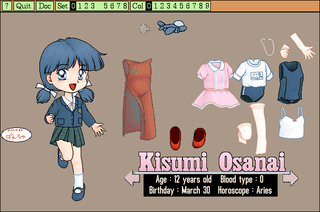Related Research Articles

Lara Croft is a character and the main protagonist of the video game franchise Tomb Raider. She is presented as a highly intelligent and athletic British archaeologist who ventures into ancient tombs and hazardous ruins around the world. Created by a team at British developer Core Design that included Toby Gard, the character first appeared in the video game Tomb Raider in 1996.
Game studies, also known as ludology, is the study of games, the act of playing them, and the players and cultures surrounding them. It is a field of cultural studies that deals with all types of games throughout history. This field of research utilizes the tactics of, at least, folkloristics and cultural heritage, sociology and psychology, while examining aspects of the design of the game, the players in the game, and the role the game plays in its society or culture. Game studies is oftentimes confused with the study of video games, but this is only one area of focus; in reality game studies encompasses all types of gaming, including sports, board games, etc.
Video game modding is the process of alteration by players or fans of one or more aspects of a video game, such as how it looks or behaves, and is a sub-discipline of general modding. Mods may range from small changes and tweaks to complete overhauls, and can extend the replay value and interest of the game.
Video game art is a specialized form of computer art employing video games as the artistic medium. Video game art often involves the use of patched or modified video games or the repurposing of existing games or game structures, however it relies on a broader range of artistic techniques and outcomes than artistic modification and it may also include painting, sculpture, appropriation, in-game intervention and performance, sampling, etc. It may also include the creation of art games either from scratch or by modifying existing games. Notable examples of video game art include Cory Arcangel's Super Mario Clouds and I Shot Andy Warhol, Joseph Delappe's projects including "Dead in Iraq" and the "Salt Satyagraha Online: Gandhi's March to Dandi in Second Life," the 2004-2005 Rhizome Commissions "relating to the theme of games," Paolo Pedercini's Molleindustria games such as "Unmanned" and "Every Day the Same Dream", and Ian Bogost's "Cowclicker."
Gonzalo Frasca is a game designer and academic researcher focusing on serious and political videogames. His blog, Ludology.org, was cited by NBC News as a popular designation for academic researchers studying video games. For many years, Frasca also co-published Watercoolergames with Ian Bogost, a blog about serious games.

Kisekae Set System is a blending of art with computers originally designed to allow creation of virtual "paper dolls". Kisekae is short for kisekae ningyou, a Japanese term meaning "dress-up dolls". Unlike "computer art" which creates or displays traditional art via a computer, KiSS uses the computer as the medium, allowing the art to be not only animated, but also interactive.

Anne-Marie Slaughter is an American international lawyer, foreign policy analyst, political scientist and public commentator. From 2002 to 2009, she was the dean of Princeton University's School of Public and International Affairs and the Bert G. Kerstetter '66 university professor of politics and international affairs. Slaughter was the first woman to serve as the director of policy planning for the U.S. State Department from January 2009 until February 2011 under U.S. secretary of state Hillary Clinton. She is a former president of the American Society of International Law and the current president and CEO of New America.
Psycho may refer to:

Suzanne Seggerman is the co-founder of Games for Change and is a public speaker and adviser on new media and social impact. At the 2015 Annual Game Developers Conference she was given an award by the Higher Education Video Game Alliance along with Dr. Mary Flanagan, Professor of Film and Media at Dartmouth College and Dr. James Paul Gee, Professor of Literacy Studies at Arizona State University.

Stefano Gualeni is an Italian philosopher, associate professor, and game designer who has created interactable websites and video games such as Tony Tough and the Night of Roasted Moths,Gua-Le-Ni; or, The Horrendous Parade, and Something Something Soup Something.
Brody Condon is an American artist. He facilitates and documents game-like group encounters that experientially probe dissociative phenomena, critical psychology, and performance art history. The resulting immersive situations, video and objects are often made in collaboration with researchers, craftspeople, and public participants.

A ludic interface is an inherently "playful" type of computer interface. This field of human–computer interaction research and design draws on concepts introduced by Dutch historian and cultural theorist Johan Huizinga in the book Homo Ludens . Huizinga's work is considered an important contribution to the development of game studies.

Anna Anthropy is an American video game designer, role-playing game designer, and interactive fiction author whose works include Mighty Jill Off and Dys4ia. She is the game designer in residence at the DePaul University College of Computing and Digital Media.

Sally Haslanger is an American philosopher and the Ford Professor of Philosophy in the Department of Linguistics and Philosophy at the Massachusetts Institute of Technology.

An art game is a work of interactive new media digital software art as well as a member of the "art game" subgenre of the serious video game. The term "art game" was first used academically in 2002 and it has come to be understood as describing a video game designed to emphasize art or whose structure is intended to produce some kind of reaction in its audience. Art games are interactive and the result of artistic intent by the party offering the piece for consideration. They also typically go out of their way to have a unique, unconventional look, often standing out for aesthetic beauty or complexity in design. The concept has been extended by some art theorists to the realm of modified ("modded") gaming when modifications have been made to existing non-art games to produce graphic results intended to be viewed as an artistic display, as opposed to modifications intended to change game play scenarios or for storytelling. Modified games created for artistic purposes are sometimes referred to as "video game art".

Sascha Pohflepp was a German artist, designer, and writer whose work focused on the role of technology’s influence on the environment, often collaborating with scientists and other artists to explore this theme.

Procedural rhetoric or simulation rhetoric is a rhetorical concept that explains how people learn through the authorship of rules and processes. The theory argues that games can make strong claims about how the world works—not simply through words or visuals but through the processes they embody and models they construct. The term was first coined by Ian Bogost in his 2007 book Persuasive Games: The Expressive Power of Videogames.

Urban planning, also known as town planning, city planning, regional planning, or rural planning, is a technical and political process that is focused on the development and design of land use and the built environment, including air, water, and the infrastructure passing into and out of urban areas, such as transportation, communications, and distribution networks and their accessibility. Traditionally, urban planning followed a top-down approach in master planning the physical layout of human settlements. The primary concern was the public welfare, which included considerations of efficiency, sanitation, protection and use of the environment, as well as effects of the master plans on the social and economic activities. Over time, urban planning has adopted a focus on the social and environmental bottom-lines that focus on planning as a tool to improve the health and well-being of people while maintaining sustainability standards. Sustainable development was added as one of the main goals of all planning endeavors in the late 20th century when the detrimental economic and the environmental impacts of the previous models of planning had become apparent. Similarly, in the early 21st century, Jane Jacobs's writings on legal and political perspectives to emphasize the interests of residents, businesses and communities effectively influenced urban planners to take into broader consideration of resident experiences and needs while planning.

Tales of Berseria is an action role-playing video game developed and published by Bandai Namco Entertainment for PlayStation 3, PlayStation 4, and Windows. It is the sixteenth main entry in the Tales series and a prequel of Tales of Zestiria. It was released in Japan for PlayStation 3 and PlayStation 4 in mid-August 2016, and was released worldwide for PlayStation 4 and Windows in late January 2017. A manga adaptation of this game was serialized on Ichijinsha's Monthly Comic Rex Magazine since October 2016. The third and last volume was published August 2018 with an English translation finishing April 2020.

Joseph DeLappe is a UK-based American artist and academic best known for his art intervention pieces that explore contemporary issues in politics through new media installations and interactive gaming performances.
References
- ↑ "Anne-Marie Schleiner". Video Data Bank. Retrieved 7 March 2015.
- ↑ "Interview with Anne-Marie Schleiner". Rhizome. Retrieved 7 March 2015.
- ↑ "Anne-Marie Schleiner". Akademie Schloss Solitude . Retrieved 7 March 2015.
- ↑ Stalbaum, Brett. "ANNE-MARIE SCHLEINER and LUIS HERNANDEZ – ICAM lecture series". Rhizome. Retrieved 7 March 2015.
- ↑ "CADRE Labs | Computers in Art, Design, Research, and Education". 2015-03-06. Archived from the original on 2015-03-06. Retrieved 2023-11-07.
- 1 2 "MS ANNE MARIE SCHLEINER INSTRUCTOR". National University of Singapore. Archived from the original on 9 March 2015. Retrieved 7 March 2015.
- ↑ Schleiner, Anne-Marie (2012-01-01). "Ludic mutation: the player's power to change the game". Amsterdam: [s.n.] OCLC 928157236.
{{cite journal}}: Cite journal requires|journal=(help) - ↑ Clarke, Andy (2007). Videogames and Art . Bristol, UK: Intellect. ISBN 9781841501420. OCLC 127259132.
- ↑ Buckendorff, Jennifer (4 May 2004). "The "Velvet-Strike" underground". Salon.com. Retrieved 7 March 2015.
- ↑ "O . U . T ". www.opensorcery.net. Retrieved 2017-03-10.
- ↑ Mary, Flanagan (2013-01-01). Critical play radical game design. MIT Press. ISBN 9780262518659. OCLC 935016500.
- ↑ "Killer Instinct in the Zenith Media Lounge". Absolute Arts. Retrieved 7 March 2015.
- ↑ Schleiner, Anne-Marie (2017). The player's power to change the game: ludic mutation. Amsterdam: Amsterdam University Press. ISBN 9789089647726. OCLC 978354257.
- ↑ "Anne Marie Schleiner".
- ↑ Schleiner, Anne-Marie (2020). Transnational Play: Piracy, Urban Art, and Mobile Games. Amsterdam: Amsterdam University Press. p. 161. ISBN 9789048543946.